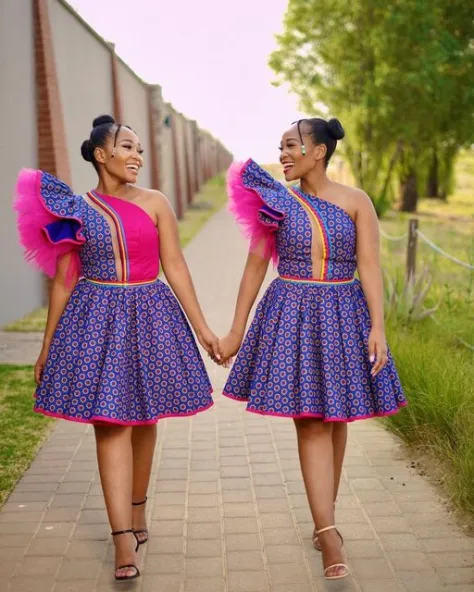Step into South African fashion, and you'll undoubtedly encounter the mesmerizing beauty of the Shweshwe fabric. With its distinctive prints, rich history, and cultural significance, this iconic textile has become a symbol of South African identity and a source of inspiration for designers around the globe. In this blog post, we delve into the captivating story of the Shweshwe fabric, exploring its origins, characteristics, and enduring influence on the fashion world.
A Brief History
Shweshwe fabric, locally named after King Moshoeshoe I of Lesotho, has a rich history in Asia and Europe before finding its home in Africa, particularly South Africa. Introduced to King Moshoeshoe I by French missionaries in the 1840s, the fabric gained popularity among the Sotho people and became known by names such as "sejeremane" and "ujamani." Its journey started in the Dutch Cape Colony in the 17th century, with exclusive indigo-dyed cloth from India and Bengal. Over time, Shweshwe evolved and became significant among African communities. In the 21st century, it experienced a revival in contemporary fashion, with South African designers showcasing its versatility and striking designs on international runways. Today, Shweshwe fabric remains a vibrant and essential feature of South African fashion, embraced in various applications, including clothing, accessories, and home decor.
Manufacturing
Shweshwe fabric is characterized by its stiff cotton texture, which softens with each wash, and its distinctive indigo-blue color. It is produced using an acid discharge and roller printing technique on pure cotton calico. The fabric is printed in widths of 90 cm and features various designs such as florals, stripes, and geometric patterns like diamonds, squares, and circles. These intricate patterns are created using the picotage technique, a rare and complex fabric printing method. While contemporary fabric manufacturers often use modern printing techniques, Da Gama Textiles, located in the Zwelitsha township of the Eastern Cape, has been manufacturing Shweshwe fabric since 1982. They acquired the rights to the popular brand Three Cats in 1992 and have produced Shweshwe using imported cotton from Zimbabwe and locally grown cotton in the Eastern Cape.
Symbolism and Uses
Shweshwe fabric, rooted in South African tradition, features geometric patterns with cultural symbolism, representing aspects of life such as fertility and spirituality. It holds profound cultural significance, symbolizing identity, celebrating milestones, and preserving ancestral traditions.
Wearing Shweshwe clothing allows individuals to proudly display their heritage and stay connected to their cultural roots, reflecting the beauty of African aesthetics and cultural diversity. The fabric, known for its vibrant patterns and colors, is traditionally used for creating garments like dresses and aprons, particularly for newly married Xhosa and Sotho women. It has also found a place in contemporary South African fashion, embraced by people from various ethnic backgrounds, and is utilized for accessories, upholstery, and even in quilting projects in the United States.
Shweshwe in Modern Fashion
The Shweshwe fabric is a testament to the power of cultural expression and the resilience of traditional craftsmanship. Its intricate patterns, vibrant colors, and rich history have made it an integral part of South African fashion and a source of inspiration for designers worldwide. As this fabric continues evolving and enchanting, it symbolizes cultural pride and an enduring connection to South Africa's vibrant heritage.
Wrapped in Shweshwe, we don't just wear fashion; we wear history, pride, and the soulful rhythm of South Africa's artistic heartbeat. - La Djalobienne Eton
References:
https://deluxefabrics.co.za/brief-history-of-shweshwe-fabric/

















No comments:
Post a Comment